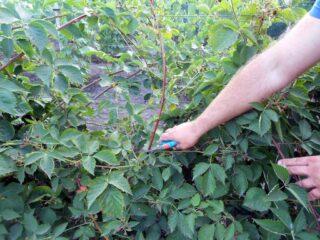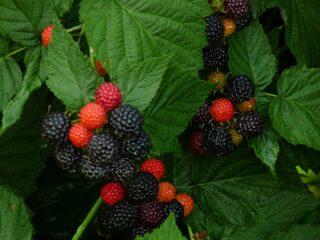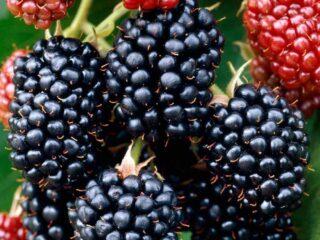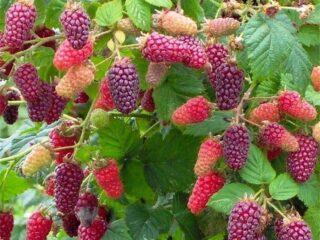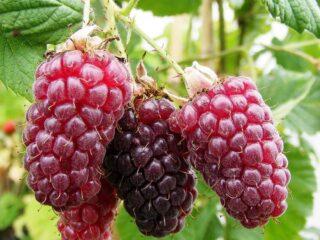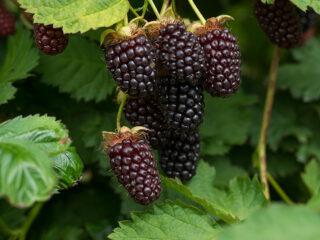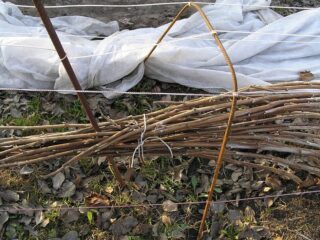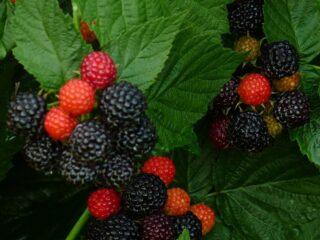Content
- 1 History of selection
- 2 Description of the Boysenberry variety
- 3 Characteristics of Boysenberry raspberry
- 4 Advantages and disadvantages of the variety
- 5 Planting Boysenberry raspberry
- 6 Boysenberry raspberry care
- 7 Propagation of Boysenberry
- 8 Conclusion
- 9 Reviews from gardeners about Boysenberry raspberries
Ezhemalina Boysenberry is considered one of the best varieties of the crop due to its high taste. However, due to the average level of productivity, it has not gained wide popularity among professionals, but it has been appreciated by amateur gardeners. Because it is about this type of Boysenberry raspberry that we can say: the main thing is not quantity, but quality. However, if you follow the rules of planting and care, you can significantly increase its productivity. Therefore, you need to become familiar with the basic requirements of the culture.
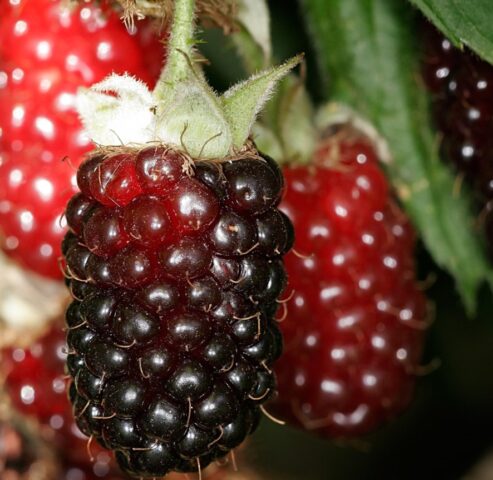
Boysenberry variety combines the best qualities of raspberries and blackberries
History of selection
The Boysenberry raspberry-blackberry hybrid was developed in 1923 in California. The basis for the species was an unknown variety of raspberries, blackberries and loganberries. Local farmer Rudolf Boysen is considered its creator, which gave the variety its name.The experiment was so successful that subsequently attempts were made to develop new clones of this hybrid variety. But, despite this, Boysenberry raspberry has not lost its relevance for many years due to the excellent taste of the berries.
Description of the Boysenberry variety
The hybrid has characteristic differences from other crop varieties. And to successfully grow Boysenberry raspberries in your personal plot, you need to know the features of its growth.
Appearance of the bush
The hybrid belongs to the category of creeping crop species. Its shoots are flexible and branch strongly and do not require pinching. Their length reaches 2-4 m. Basically, there are no thorns on the branches, but if the roots are damaged, prickly growth may appear at the base of the bush.
Young shoots of Boysenberry raspberry are green, but as they mature they acquire a reddish tint. The branches have a two-year life potential.
The structure of the bush resembles raspberries and blackberries at the same time. At the base, its shoots grow straight upward, and higher up they begin to spread. The leaves of the Boysenberry hybrid are feathery, light green in color, with jagged edges and a pointed tip. They consist of 5-7 separate segments and are attached to one elongated petiole. The root system of the fruit bush is well developed, reaching deep layers of soil.
The flowers of the Boysenberry raspberry are simple, small in size, consisting of five rounded petals. The buds are collected in racemose inflorescences that appear from the axils of the leaves.
Description and taste of berries
The fruits of the Boysenberry raspberry are oval-elongated. During the growth period they change their color several times.Initially, the berries are green, then red, and subsequently acquire an almost black tint.
The average fruit weight is 10-12 g, and in adult shrubs the weight of individual specimens may be greater. The drupe of the Boysenberry raspberry is well-knit, without gloss, and juicy. The taste of the berries is bright, refined, combines notes of raspberry and blackberry, sweet. The fruits are fragrant. The tasting rating of the variety is 4.8 points out of a possible 5.
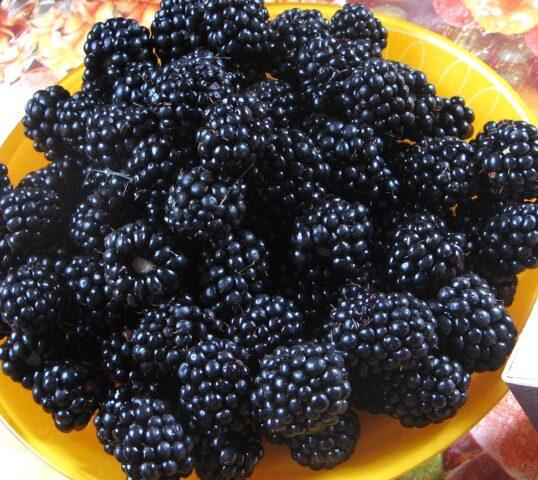
When the crop is fully ripe, the berries of the Boysenberry raspberry are dry torn off
Characteristics of Boysenberry raspberry
To provide the hybrid with proper care and growing conditions, you need to know the basic requirements of the crop. And for this you need to familiarize yourself with its main characteristics.
Flowering period, ripening period and yield
In the first ten days of May, buds begin to bloom on the bush. The flowering period of Boysenberry raspberry lasts one month. Beginning at the end of June, the berries ripen. The variety is characterized by extended fruiting, which lasts for 2-3 weeks. Therefore, harvesting must be carried out in several stages.
Boysenberry raspberries are suitable for fresh consumption and winter preparations. The yield per bush is 5 kg.
Frost resistance
This hybrid has an average level of frost resistance. It is able to withstand temperatures down to -18 °C.Therefore, to successfully grow Boysenberry raspberry in the central and northern regions, it is necessary to remove the shoots from the trellis, bend them to the ground and insulate them for the winter.
It is also recommended to additionally throw snow on top throughout the entire cold period to protect against freezing. Otherwise, you will not be able to get a high yield.
Resistance to diseases and pests
One of the advantages of Boysenberry raspberry is its high natural immunity. Therefore, the shrub is little susceptible to pests and diseases. But in case of dense plantings, which leads to insufficient ventilation of the bushes, it can be mildly affected by anthracnose.
Advantages and disadvantages of the variety
Boysenberry raspberry has many advantages that set it apart from other types of crops. But this hybrid also has certain disadvantages that must be taken into account.
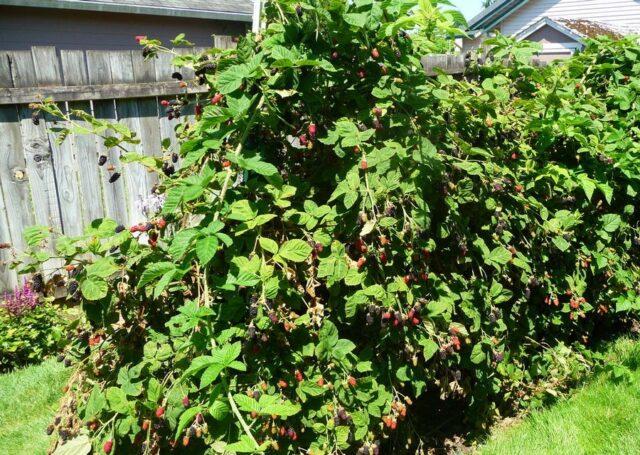
With proper care, this fruit shrub can grow in one place for up to 8-10 years.
The main benefits of Boysenberry raspberry:
- large fruit;
- dessert taste;
- pleasant aroma;
- excellent presentation;
- does not require pinching shoots;
- high life potential;
- annual fruiting;
- powerful growth force of the bush;
- universal use of berries;
- thornlessness;
- low susceptibility to diseases and pests.
Flaws:
- average level of frost resistance;
- low yield;
- may produce thorny growth;
- the crop is not suitable for transportation.
Planting Boysenberry raspberry
The hybrid is one of the light-loving plants. For it you need to choose well-lit areas throughout the day. With a lack of light, Boysenberry raspberry grows shoots to the detriment of fruit formation.
It is recommended to plant the shrub in sandy or loamy soil with a low acidity level in the range of 5.5-6.5 pH. It is important that the soil has good moisture and breathability. The groundwater level in the area intended for this hybrid must be at least 1 m.
To plant Boysenberry raspberries, it is recommended to select one-year-old seedlings with a well-developed root system and no signs of damage or disease on the shoots. They can be planted in a permanent place in the spring before the growing season begins and in the fall after it ends. In the second case, it is important that at least three weeks remain before the onset of frost, otherwise the bush will not have time to take root and will die in the winter.
The site for Boysenberry raspberries must be prepared at least two weeks before planting. It needs to be dug up, all perennial weeds removed, and humus added 10 kg per square meter. m and level the surface. It is also recommended to place the seedlings in water a day before the procedure to soak the roots, which will speed up their adaptation to the new location.
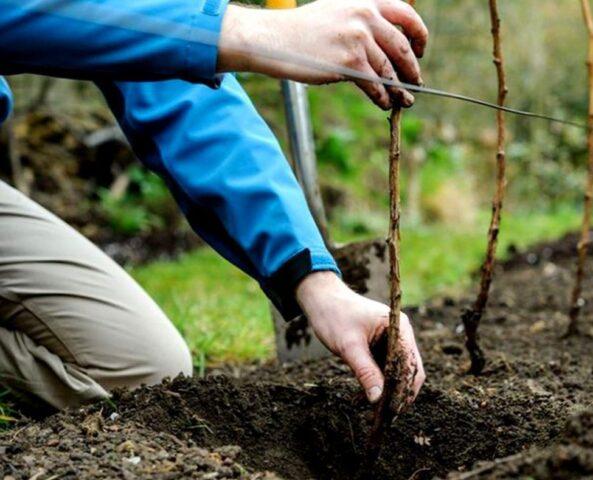
It is unacceptable to grow Boysenberry raspberries in heavy soil.
Algorithm of actions when landing:
- Make a hole measuring 40 by 40 cm.
- Place drainage at the bottom with a layer of 10 cm.
- Sprinkle it with earth on top.
- Add 100 g of wood ash and mix it with the soil.
- Place the seedling in the center without deepening the root collar.
- Sprinkle the roots with soil and fill all the voids.
- Compact the soil at the base of the raspberry tree.
- Water generously.
The next day, mulch the soil at the base of the bush with peat or humus. When planting several Boysenberry seedlings, it is necessary to maintain a distance of 1 m, and maintain a distance of 2 m in a row.
Boysenberry raspberry care
To successfully grow a hybrid, you must follow some care rules. All of them are aimed at maintaining the vitality of the plant, which will allow the bush to fully develop and bear fruit.
The Boysenberry raspberry variety can easily tolerate short-term drought, but in the absence of rain for a long time it needs moderate watering. Moisturize in the evening using settled water. The frequency of the procedure is twice a week. During the hottest periods, in order to reduce the evaporation of moisture from the soil, it is recommended to place a 3 cm layer of mulch at the base of the Boysenberry raspberry tree.
Boysenberry Ezhemalina is a creeping shrub that needs to be tied to a support. To do this, it is recommended to use trellises 2.5 m high with transverse rows of tensioned wire. In early spring, you need to direct and tie overwintered shoots to the right side, and young growing shoots to the left. In the fall, cut off all branches that have lost their potential at the base, and from the one-year ones, select no more than ten of the most developed ones, and remove the rest.
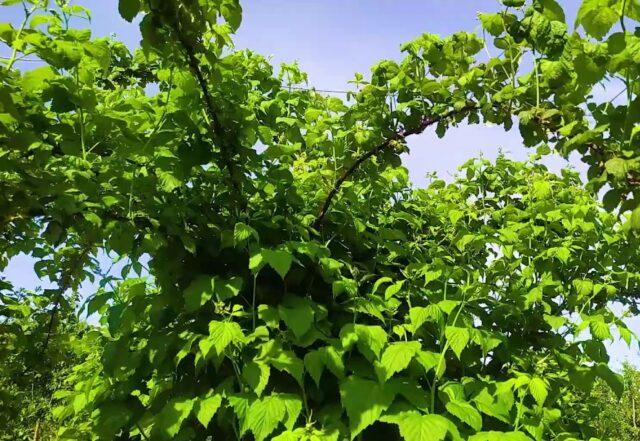
If the bush grows excessively, the yield decreases and the size of the berries decreases
It is recommended to feed Boysenberry raspberry twice a season. Fertilize for the first time in the spring, using organic matter: chicken manure 1:15 or mullein 1:10. And carry out the second feeding after fruiting. At this time, you need to use superphosphate 40 g and potassium sulphide 25 g per bucket of water.
In late autumn, after clearing the bushes, it is recommended to lay mulch at their base in a layer of 10 cm, then lay the shoots on the ground, previously covered with roofing felt. They need to be covered with agrofibre and spruce branches.
Propagation of Boysenberry
This hybrid is easily propagated by layering and cuttings. In the first case, before the beginning of the growing season in early spring, it is necessary to deepen the plant shoot into the soil by 10 cm and secure it with a bracket. Subsequently, throughout the entire season, keep the soil slightly moist and periodically add soil under the germinating Boysenberry seedlings. They can be transplanted to a permanent place only after a year.
It is recommended to cut the hybrid at the end of flowering in the first half of June. In this case, you need to cut the semi-lignified shoots into pieces with 2-3 buds and plant them in the ground. For better rooting, install a mini-greenhouse on top. The sprouts should be regularly ventilated and moistened as the top layer of soil dries. Young Boysenberry seedlings can be transferred to a permanent place when they are strong enough and begin to grow. After this, they need to be cared for, just like adult plants.
Conclusion
Boysenberry Ezhemalina is a fruit shrub that many gardeners prefer to grow. And although it is inferior in yield to other types of crops, the taste of its berries will not leave anyone indifferent. Therefore, for personal use, according to experts, the variety is the best.
